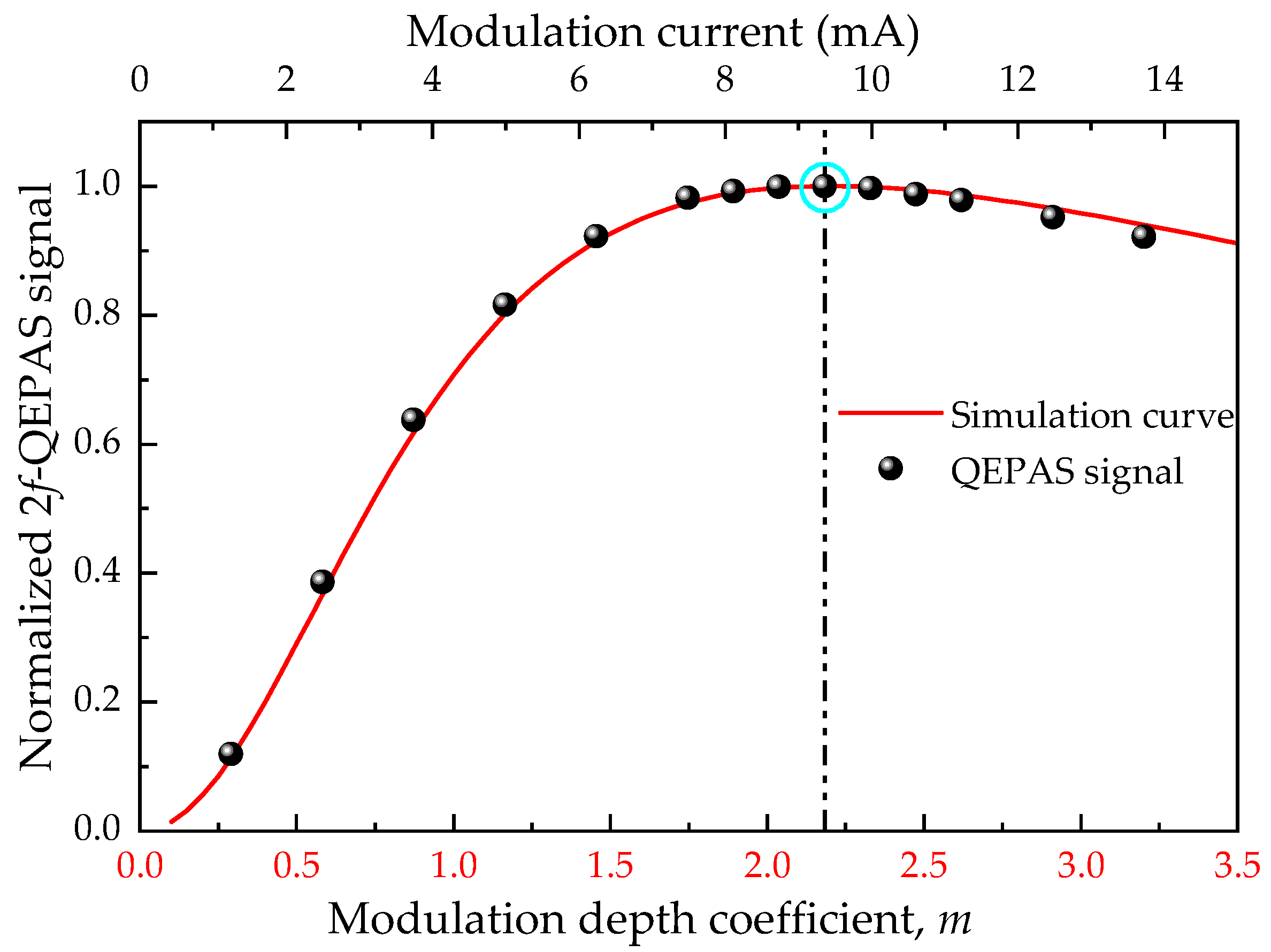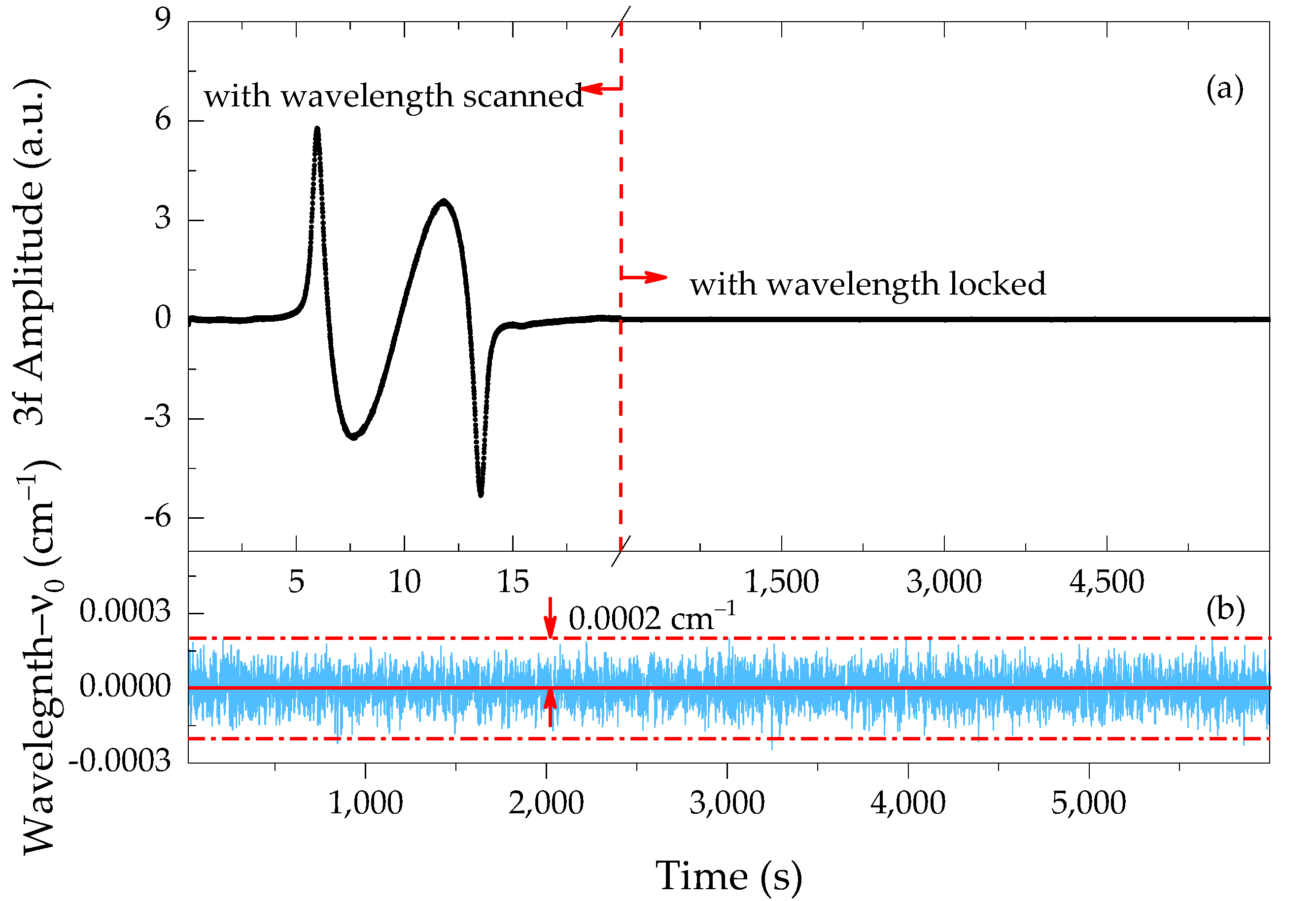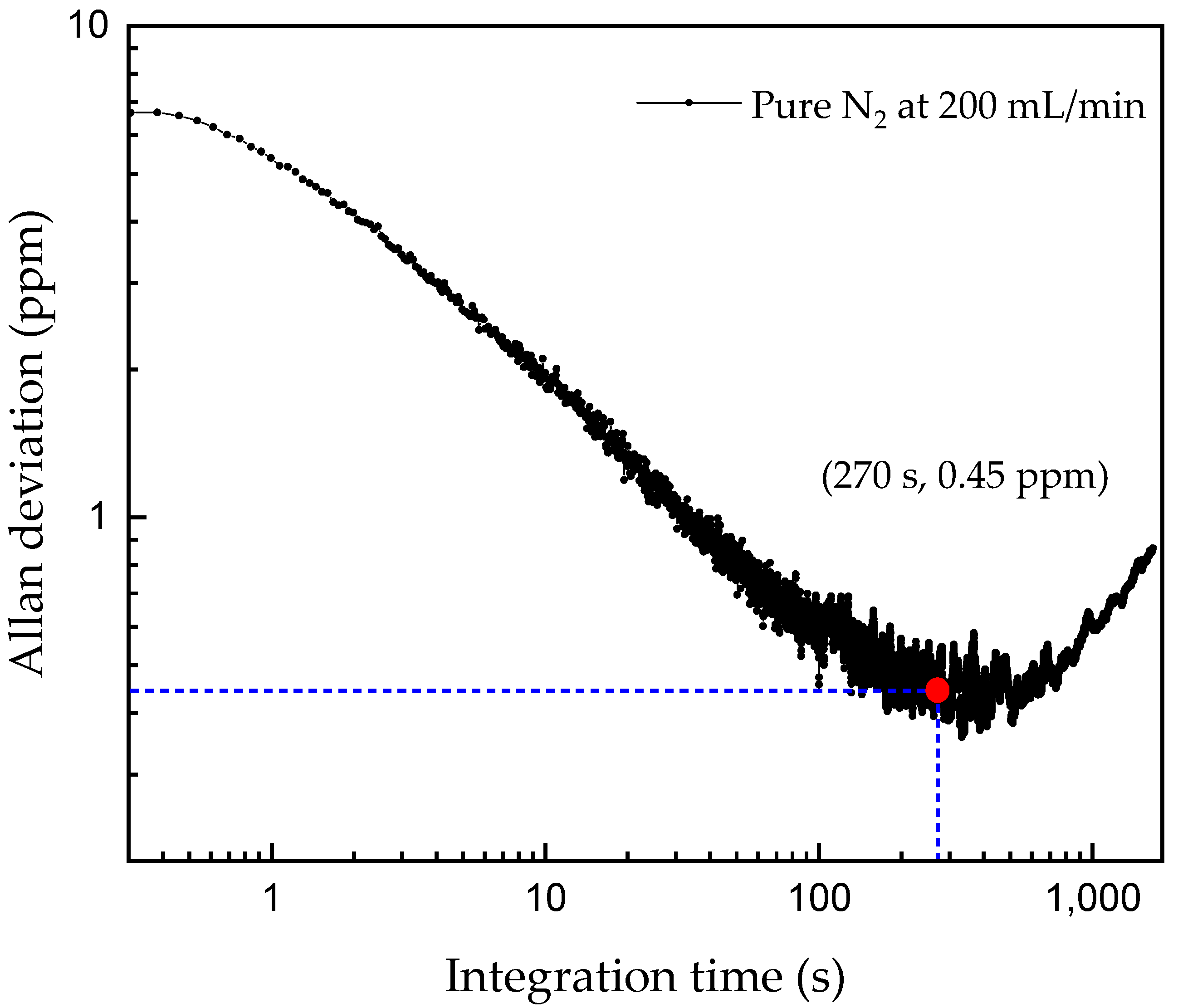Investigation and Optimization of a Line-Locked Quartz Enhanced Spectrophone for Rapid Carbon Dioxide Measurement
Abstract
:1. Introduction
2. Sensor Configuration and Line-Locked Process
3. Experimental Results and Discussion
3.1. Response Time of the QTF Spectrophone
3.2. Feedback Interval Determination
3.3. Line-Locked Wavelength Stabilization
3.4. Sensor Performance
3.5. Field Applications for Atmospheric and Exhaled CO2 Measurement
4. Conclusions
Author Contributions
Funding
Institutional Review Board Statement
Informed Consent Statement
Data Availability Statement
Conflicts of Interest
Appendix A

Appendix B

Appendix C

References
- Snyder, C.S.; Bruulsema, T.W.; Jensen, T.L.; Fixen, P.E. Review of Greenhouse Gas Emissions from Crop Production Systems and Fertilizer Management Effects. Agric. Ecosyst. Environ. 2009, 133, 247–266. [Google Scholar] [CrossRef]
- Wang, Z.; Wang, Q.; Ching, J.Y.-L.; Wu, J.C.-Y.; Zhang, G.; Ren, W. A Portable Low-Power QEPAS-Based CO2 Isotope Sensor Using a Fiber-Coupled Interband Cascade Laser. Sens. Actuators B Chem. 2017, 246, 710–715. [Google Scholar] [CrossRef]
- Delli Santi, M.G.; Bartalini, S.; Cancio, P.; Galli, I.; Giusfredi, G.; Haraldsson, C.; Mazzotti, D.; Pesonen, A.; De Natale, P. Biogenic Fraction Determination in Fuel Blends by Laser-Based 14CO2 Detection. Adv. Photonics Res. 2021, 2, 2000069. [Google Scholar] [CrossRef]
- Willer, U.; Saraji, M.; Khorsandi, A.; Geiser, P.; Schade, W. Near- and Mid-Infrared Laser Monitoring of Industrial Processes, Environment and Security Applications. Opt. Lasers Eng. 2006, 44, 699–710. [Google Scholar] [CrossRef]
- Zhang, H.; Wen, M.; Li, Y.; Wan, P.; Chen, C. High-Precision 13CO2/12CO2 Isotopic Ratio Measurement Using Tunable Diode Laser Absorption Spectroscopy at 4.3 μm for Deep-Sea Natural Gas Hydrate Exploration. Appl. Sci. 2019, 9, 3444. [Google Scholar] [CrossRef] [Green Version]
- Bozóki, Z.; Pogány, A.; Szabó, G. Photoacoustic Instruments for Practical Applications: Present, Potentials, and Future Challenges. Appl. Spectrosc. Rev. 2011, 46, 1–37. [Google Scholar] [CrossRef]
- Hodgkinson, J.; Tatam, R.P. Optical Gas Sensing: A Review. Meas. Sci. Technol. 2013, 24, 012004. [Google Scholar] [CrossRef] [Green Version]
- Palzer, S. Photoacoustic-Based Gas Sensing: A Review. Sensors 2020, 20, 2745. [Google Scholar] [CrossRef]
- Patimisco, P.; Sampaolo, A.; Dong, L.; Tittel, F.K.; Spagnolo, V. Recent Advances in Quartz Enhanced Photoacoustic Sensing. Appl. Phys. Rev. 2018, 5, 011106. [Google Scholar] [CrossRef]
- Ma, Y. Recent Advances in QEPAS and QEPTS Based Trace Gas Sensing: A Review. Front. Phys. 2020, 8, 268. [Google Scholar] [CrossRef]
- Kosterev, A.A.; Bakhirkin, Y.A.; Curl, R.F.; Tittel, F.K. Quartz-Enhanced Photoacoustic Spectroscopy. Opt. Lett. 2002, 27, 1902. [Google Scholar] [CrossRef] [Green Version]
- Borri, S.; Patimisco, P.; Galli, I.; Mazzotti, D.; Giusfredi, G.; Akikusa, N.; Yamanishi, M.; Scamarcio, G.; De Natale, P.; Spagnolo, V. Intracavity Quartz-Enhanced Photoacoustic Sensor. Appl. Phys. Lett. 2014, 104, 91114. [Google Scholar] [CrossRef]
- Wysocki, G.; Kosterev, A.A.; Tittel, F.K. Influence of Molecular Relaxation Dynamics on Quartz-Enhanced Photoacoustic Detection of CO2 at λ =2 μm. Appl. Phys. B 2006, 85, 301–306. [Google Scholar] [CrossRef]
- Rück, T.; Bierl, R.; Matysik, F.-M. NO2 Trace Gas Monitoring in Air Using Off-Beam Quartz Enhanced Photoacoustic Spectroscopy (QEPAS) and Interference Studies towards CO2, H2O and Acoustic Noise. Sens. Actuators B Chem. 2018, 255, 2462–2471. [Google Scholar] [CrossRef]
- Lewicki, R.; Wysocki, G.; Kosterev, A.A.; Tittel, F.K. Carbon Dioxide and Ammonia Detection Using 2 μm Diode Laser Based Quartz-Enhanced Photoacoustic Spectroscopy. Appl. Phys. B 2007, 87, 157–162. [Google Scholar] [CrossRef]
- Zheng, H.; Liu, Y.; Lin, H.; Kan, R.; Dong, L.; Zhu, W.; Fang, J.; Yu, J.; Tittel, F.K.; Chen, Z. Quartz-Enhanced Photoacoustic Spectroscopy Exploiting a Fast and Wideband Electro-Mechanical Light Modulator. Opt. Express 2020, 28, 27966. [Google Scholar] [CrossRef]
- Yang, G.; Xu, L.; Liang, H.; Li, J. Quartz-Tuning-Fork-Enhanced Spectroscopy Based on Fast Fourier Transform Algorithm. Front. Phys. 2020, 8, 582503. [Google Scholar] [CrossRef]
- Xu, L.; Zhou, S.; Liu, N.; Zhang, M.; Liang, J.; Li, J. Multigas Sensing Technique Based on Quartz Crystal Tuning Fork-Enhanced Laser Spectroscopy. Anal. Chem. 2020, 92, 14153–14163. [Google Scholar] [CrossRef] [PubMed]
- Dello Russo, S.; Sampaolo, A.; Patimisco, P.; Menduni, G.; Giglio, M.; Hoelzl, C.; Passaro, V.M.N.; Wu, H.; Dong, L.; Spagnolo, V. Quartz-Enhanced Photoacoustic Spectroscopy Exploiting Low-Frequency Tuning Forks as a Tool to Measure the Vibrational Relaxation Rate in Gas Species. Photoacoustics 2021, 21, 100227. [Google Scholar] [CrossRef] [PubMed]
- Borri, S.; Patimisco, P.; Sampaolo, A.; Beere, H.E.; Ritchie, D.A.; Vitiello, M.S.; Scamarcio, G.; Spagnolo, V. Terahertz Quartz Enhanced Photo-Acoustic Sensor. Appl. Phys. Lett. 2013, 103, 021105. [Google Scholar] [CrossRef]
- Patimisco, P.; Sampaolo, A.; Dong, L.; Giglio, M.; Scamarcio, G.; Tittel, F.K.; Spagnolo, V. Analysis of the Electro-Elastic Properties of Custom Quartz Tuning Forks for Optoacoustic Gas Sensing. Sens. Actuators B Chem. 2016, 227, 539–546. [Google Scholar] [CrossRef]
- Kosterev, A.A.; Buerki, P.R.; Dong, L.; Reed, M.; Day, T.; Tittel, F.K. QEPAS Detector for Rapid Spectral Measurements. Appl. Phys. B 2010, 100, 173–180. [Google Scholar] [CrossRef]
- Wang, Q.; Wang, Z.; Ren, W. Wavelength-Stabilization-Based Photoacoustic Spectroscopy for Methane Detection. Meas. Sci. Technol. 2017, 28, 065102. [Google Scholar] [CrossRef]
- Wang, Z.; Yang, M.; Fu, L.; Chen, C.; You, R.; Ren, W. Rapid Field Measurement of Ventilation Rate Using a Quartz-Enhanced Photoacoustic SF6 Gas Sensor. Meas. Sci. Technol. 2020, 31, 085105. [Google Scholar] [CrossRef]
- Wang, Z.; Chang, J.; Yu, H.; Tian, C.; Zhang, H.; Zhang, X.; Tang, L.; Zhang, Q.; Feng, Y. Multi-Component and Multi-Point Trace Gas Sensing in Wavelength Modulation Spectroscopy Based on Wavelength Stabilization. Photonic Sens. 2019, 9, 376–387. [Google Scholar] [CrossRef] [Green Version]
- Patimisco, P.; Scamarcio, G.; Tittel, F.; Spagnolo, V. Quartz-Enhanced Photoacoustic Spectroscopy: A Review. Sensors 2014, 14, 6165–6206. [Google Scholar] [CrossRef] [PubMed] [Green Version]
- Wu, H.; Dong, L.; Zheng, H.; Yu, Y.; Ma, W.; Zhang, L.; Yin, W.; Xiao, L.; Jia, S.; Tittel, F.K. Beat frequency quartz-enhanced photoacoustic spectroscopy for fast and calibration-free continuous trace-gas monitoring. Nat. Commun. 2017, 8, 15331. [Google Scholar] [CrossRef] [Green Version]
- Li, J.; Durry, G.; Cousin, J.; Joly, L.; Parvitte, B.; Zeninari, V. Self-Induced Pressure Shift and Temperature Dependence Measurements of CO2 at 2.05μm with a Tunable Diode Laser Spectrometer. Spectrochim. Acta A. Mol. Biomol. Spectrosc. 2012, 85, 74–78. [Google Scholar] [CrossRef]
- Wu, H.; Dong, L.; Yin, X.; Sampaolo, A.; Patimisco, P.; Ma, W.; Zhang, L.; Yin, W.; Xiao, L.; Spagnolo, V. Atmospheric CH4 measurement near a landfill using an ICL-based QEPAS sensor with V-T relaxation self-calibration. Sens. Actuators B Chem. 2019, 297, 126753. [Google Scholar] [CrossRef]
- US Department of Commerce, N. Global Monitoring Laboratory—Carbon Cycle Greenhouse Gases. Available online: https://gml.noaa.gov/ccgg/ (accessed on 20 February 2021).
- Wang, C.; Sahay, P. Breath Analysis Using Laser Spectroscopic Techniques: Breath Biomarkers, Spectral Fingerprints, and Detection Limits. Sensors 2009, 9, 8230–8262. [Google Scholar] [CrossRef]
- Gordon, I.E.; Rothman, L.S.; Hill, C.; Kochanov, R.V.; Tan, Y.; Bernath, P.F.; Birk, M.; Boudon, V.; Campargue, A.; Chance, K.V.; et al. The HITRAN2016 molecular spectroscopic database. J. Quant. Spectrosc. Radiat. Transf. 2017, 203, 3–69. [Google Scholar] [CrossRef]








Publisher’s Note: MDPI stays neutral with regard to jurisdictional claims in published maps and institutional affiliations. |
© 2021 by the authors. Licensee MDPI, Basel, Switzerland. This article is an open access article distributed under the terms and conditions of the Creative Commons Attribution (CC BY) license (https://creativecommons.org/licenses/by/4.0/).
Share and Cite
Zhang, H.; Jin, W.; Hu, M.; Hu, M.; Liang, J.; Wang, Q. Investigation and Optimization of a Line-Locked Quartz Enhanced Spectrophone for Rapid Carbon Dioxide Measurement. Sensors 2021, 21, 5225. https://doi.org/10.3390/s21155225
Zhang H, Jin W, Hu M, Hu M, Liang J, Wang Q. Investigation and Optimization of a Line-Locked Quartz Enhanced Spectrophone for Rapid Carbon Dioxide Measurement. Sensors. 2021; 21(15):5225. https://doi.org/10.3390/s21155225
Chicago/Turabian StyleZhang, Hui, Wenling Jin, Mengpeng Hu, Mai Hu, Jingqiu Liang, and Qiang Wang. 2021. "Investigation and Optimization of a Line-Locked Quartz Enhanced Spectrophone for Rapid Carbon Dioxide Measurement" Sensors 21, no. 15: 5225. https://doi.org/10.3390/s21155225
APA StyleZhang, H., Jin, W., Hu, M., Hu, M., Liang, J., & Wang, Q. (2021). Investigation and Optimization of a Line-Locked Quartz Enhanced Spectrophone for Rapid Carbon Dioxide Measurement. Sensors, 21(15), 5225. https://doi.org/10.3390/s21155225






